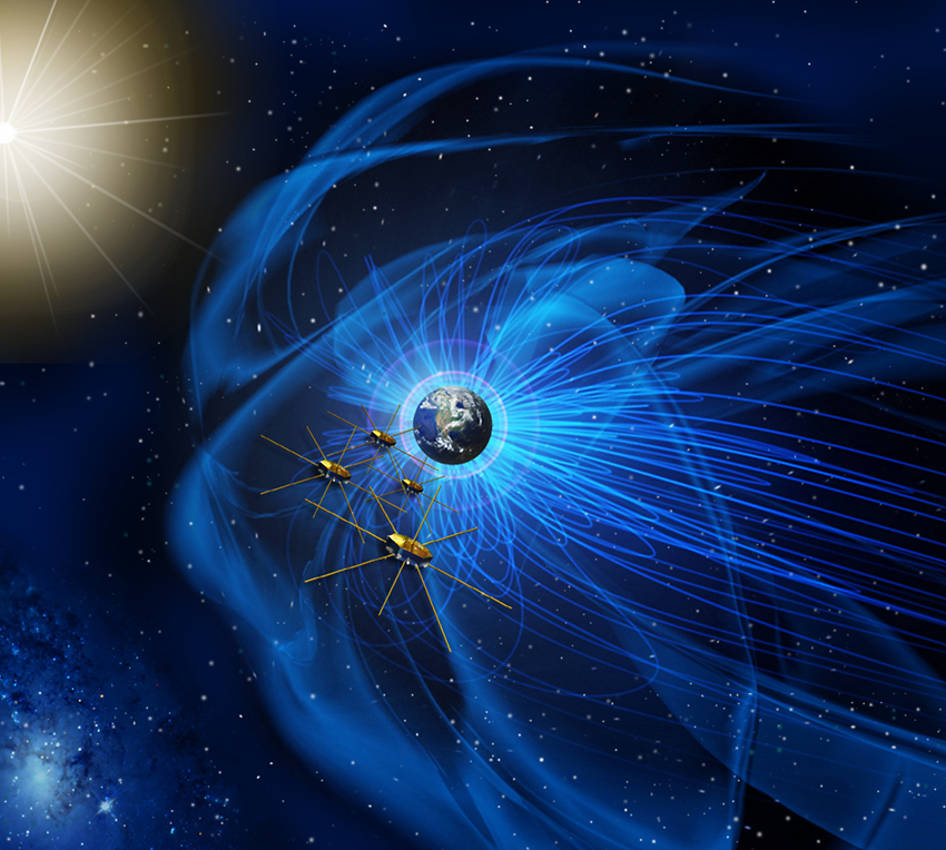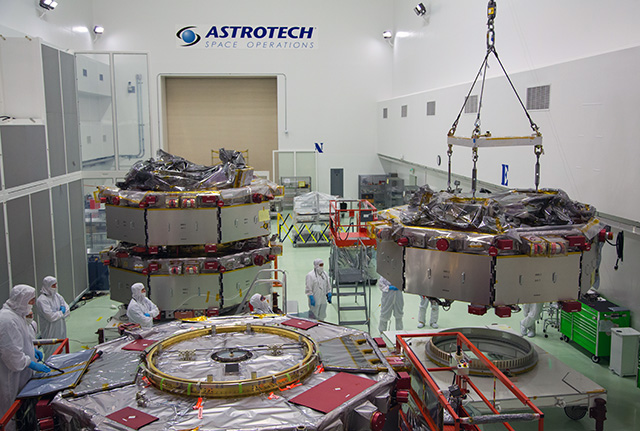NASA Satellite Quartet Aims to Crack Magnetic Mystery Near Earth

A cosmic phenomenon in Earth's magnetic field that is both dazzling and potentially dangerous for people on the surface is the focus of a new scientific mission, scheduled to launch into orbit on Thursday (March 12).
The Magnetsopheric Multiscale mission, or MMS, consists of four satellites that will study a process called magnetic reconnection: the explosive phenomenon that can send powerful bursts of particles hurtling toward Earth, potentially damaging satellites. But magnetic reconnection is also responsible for the auroras — the northern and southern lights — near Earth's poles. A new NASA video explains the MMS mission in detail.
MMS is the only dedicated instrument studying magnetic reconnection, and scientists say it could finally reveal how this phenomenon occurs. The mission requires an elaborately choreographed arrangement of four separate satellites in an orbit around Earth, placing them in the path of the magnetic reconnection events taking place right on Earth's doorstep. [NASA'S Magnetospheric Multiscale Mission in Pictures]
"[MMS] is going to actually fly in Earth's magnetosphere, this protective magnetic environment around the Earth," Jeff Newmark, interim director of NASA's heliophysics division, said in a Feb. 25 briefing. "We're using this environment around the Earth as a natural laboratory. Rather than building one on Earth, we're going to where magnetic reconnection actually occurs in space so we can understand it."
You can watch the MMS satellite launch Thursday, with NASA's webcast beginning at 8 p.m. EDT (0000 March 13 GMT). Liftoff is set for 10:44 p.m. EDT (0244 a.m. March 13 GMT) atop an unmanned Atlas V rocket. Today at 1 p.m. EDT (1700 GMT), NASA will hold a science briefing webcast to discuss the mission.
Wandering magnetic field lines

While past space missions have also recorded some data on magnetic reconnection, MMS is the first space mission dedicated solely to studying this phenomenon, according to a statement from NASA. It will collect data 100 times faster than any previous mission that has observed magnetic reconnection in space. The $1.1 billion MMS mission was built and tested at NASA's Goddard Space Flight Center in Greenbelt, Maryland.
Magnetic fields can be found all over the universe. Planets, stars, galaxies, black holes and many other bodies create magnetic field lines that can wrap tightly around their parent bodies like vines, or wander loosely into space.
Get the Space.com Newsletter
Breaking space news, the latest updates on rocket launches, skywatching events and more!
With one end attached to the positive side of a magnet, and the other end attached to the negative side, magnetic field lines are typically looped. Occasionally, a magnetic field line will snap, like a rubber band, before quickly reforming a loop. The snapping and reconnecting of magnetic field lines, also known as magnetic reconnection, releases great bursts of energy, sometimes accelerating nearby particles close to the speed of light.
"Exactly how magnetic energy is destroyed in a reconnection event is completely unknown," Jim Burch, MMS principle investigator, said in a news briefing on March 10.
When magnetic reconnection occurs in the sun it creates solar flares that explode off the surface. It can also cause coronal mass ejections, in which the solar flare belches up a storm of particles that hurtle outward into space — sometimes straight toward Earth. The planet's own magnetic field protects people on the ground from these particle storms, but orbiting satellites are at risk of being damaged.
Magnetic reconnection also happens closer to Earth: the sun's magnetic field lines stretch and wander all the way out past Mercury and Venus (where they are sometimes called interplanetary field lines), right to Earth's doorstep. The field lines bump up against the Earth's protective magnetic field — the magnetosphere — causing a few lines to break and reconnect.
In some instances, magnetic reconnection near the magnetosphere can send particles hurtling toward Earth's atmosphere, and generate one of the most stunning natural phenomena on Earth: the auroras. But magnetic reconnection can also create geomagnetic storms that send electric surges down to the surface and into power grids, potentially shorting out those grids and causing blackouts. These showers of intense particles can also pose a radiation hazard for astronauts in orbit.
Scientists working on MMS want to understand how this beautiful yet dangerous phenomenon occurs.
A satellite dance
MMS consists of four satellites, each of which weighs 3,000 lbs. (1,360 kilograms). In preparation for launch, the 4-foot-tall, 12-foot-wide octagonal satellites have been stacked on top of one another, and placed inside a protective shell atop the United Launch Alliance Atlas V rocket. [How NASA's MMS Satellites Work (Infographic)]
Once the satellites enter into their orbit, each one will unfurl a series of booms or antennas, the longest of which are 196 feet (60 meters) wide. With their metal arms fully extended, each satellite will grow to about 94 feet tall and 396 feet wide — giving each satellite a "footprint" the size of a major league baseball field.
In orbit, the four satellites will set up in a pyramid formation, so that together they can study magnetic reconnection event in three dimensions. The satellites also have a GPS system, so engineers on the ground can know where the satellites are to within 100 meters, as well as to keep the satellites to within 10 kilometers of each other.
The satellites will pass between the Earth and the sun in a region called the magnetopause: where the magnetic field lines of the two bodies meet. After two swings through the magnetopause, the MMS satellites will take a wider orbit around to Earth, to the night side, and pass through a region called the magnetotail. These two areas are where scientists hope the MMS satellites will encounter magnetic reconnection events.

"Reconnection happens at a very small region in space […] but it impacts a huge region of space, of the whole magnetosphere, which is a million miles long," said Paul Cassak, an associate professor at West Virginia University, at the Feb. 25 NASA briefing. "This makes it extremely difficult to study. Like a cosmic version of finding a needle in the haystack."
Magnetic reconnection events are somewhat rare. Burch, the principal investigator for the MMS instrument suite science team, said in an interview with Space.com that the MMS scientists do not expect to see one every day.
"We don't really know how often we'll see it," Burch said. "Our requirement is we see 16 quality events and we expect to see well more than those. Maybe on the order of every week."
At the news briefing today, Burch said he was ready for MMS to find "some surprises," as it collects data. Speaking for the MMS team, he said, "We think we have the definitive experiment on magnetic reconnection."
Follow Calla Cofield @callacofield. Follow us @Spacedotcom, Facebook and Google+. Original article on Space.com.
Join our Space Forums to keep talking space on the latest missions, night sky and more! And if you have a news tip, correction or comment, let us know at: community@space.com.

Calla Cofield joined Space.com's crew in October 2014. She enjoys writing about black holes, exploding stars, ripples in space-time, science in comic books, and all the mysteries of the cosmos. Prior to joining Space.com Calla worked as a freelance writer, with her work appearing in APS News, Symmetry magazine, Scientific American, Nature News, Physics World, and others. From 2010 to 2014 she was a producer for The Physics Central Podcast. Previously, Calla worked at the American Museum of Natural History in New York City (hands down the best office building ever) and SLAC National Accelerator Laboratory in California. Calla studied physics at the University of Massachusetts, Amherst and is originally from Sandy, Utah. In 2018, Calla left Space.com to join NASA's Jet Propulsion Laboratory media team where she oversees astronomy, physics, exoplanets and the Cold Atom Lab mission. She has been underground at three of the largest particle accelerators in the world and would really like to know what the heck dark matter is. Contact Calla via: E-Mail – Twitter









